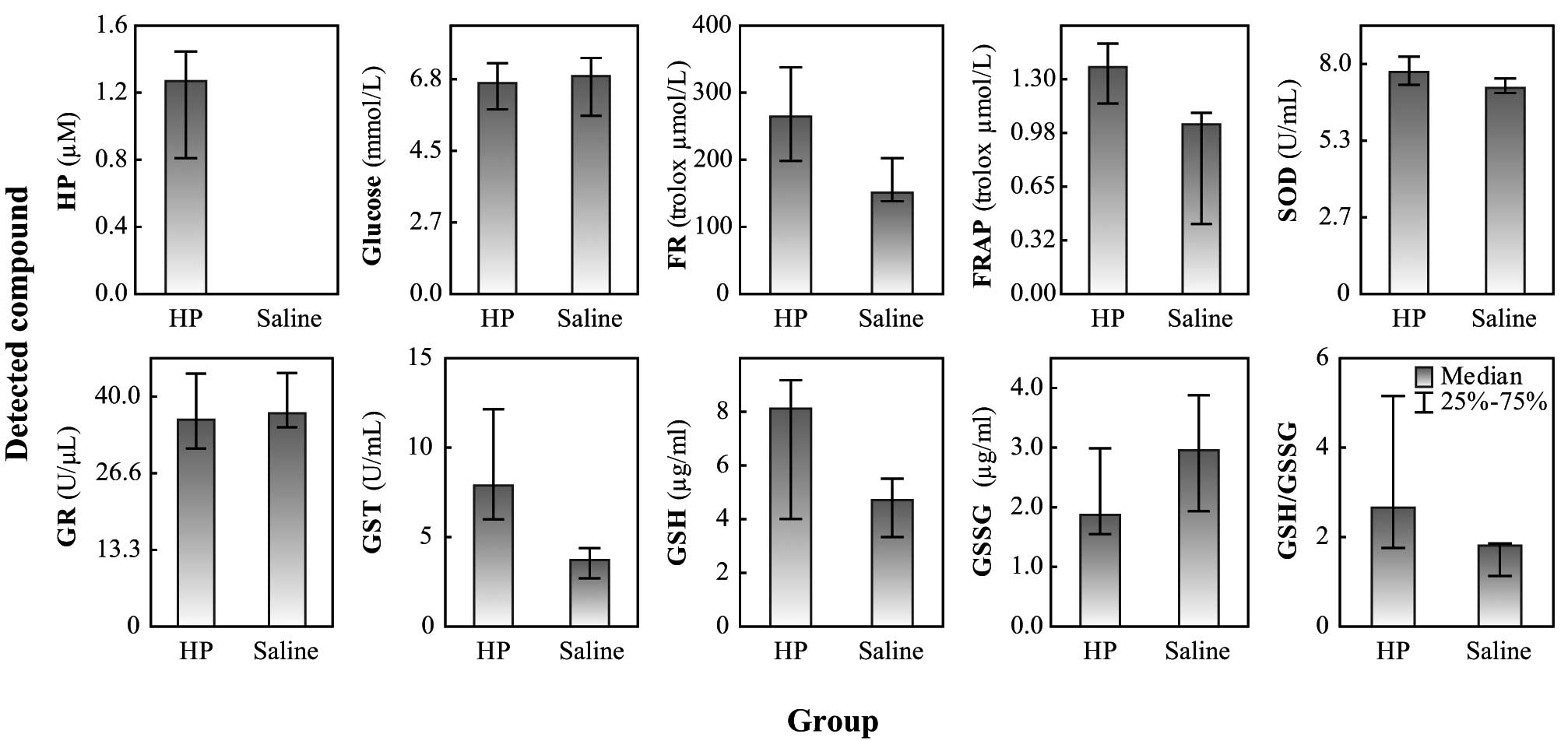|
1.
|
Janssen PA, Soudijn W, van Wijngaarden I
and Dresse A: Pimozide, a chemically novel highly potent and orally
long-acting neuroleptic drug. 3. Regional distribution of pimozide
and of haloperidol in dog brain. Arzneimittelforschung. 18:282–287.
1968.PubMed/NCBI
|
|
2.
|
Ikemura M, Nakagawa Y, Shinone K, Inoue H
and Nata M: The blood concentration and organ distribution of
haloperidol at therapeutic and toxic doses in severe fatty liver
disease. Leg Med (Tokyo). 14:147–153. 2012. View Article : Google Scholar : PubMed/NCBI
|
|
3.
|
Maxa JL, Taleghani AM, Ogu CC and Tanzi M:
Possible toxic encephalopathy following high-dose intravenous
haloperidol. Ann Pharmacother. 31:736–737. 1997.PubMed/NCBI
|
|
4.
|
Tsujimoto A, Tsujimoto G, Ishizaki T,
Nakazawa S and Ichihashi Y: Toxic haloperidol reactions with
observation of serum haloperidol concentration in two children. Dev
Pharmacol Ther. 4:12–17. 1982.PubMed/NCBI
|
|
5.
|
Engel N and Mahlknecht U: Aging and
anti-aging: Unexpected side effects of everyday medication through
sirtuin1 modulation. Int J Mol Med. 21:223–232. 2008.PubMed/NCBI
|
|
6.
|
Huang QY, Li XF and Liu SP: E-cadherin and
caveolin-1 alterations in the heart of rats having undergone
chlorpromazine-induced toxicity. Mol Med Rep. 5:705–709.
2012.PubMed/NCBI
|
|
7.
|
Breier A, Schreiber JL, Dyer J and Pickar
D: National Institute of Mental Health longitudinal study of
chronic schizophrenia. Prognosis and predictors of outcome. Arch
Gen Psychiatry. 48:239–246. 1991. View Article : Google Scholar : PubMed/NCBI
|
|
8.
|
Baldessarini RJ, Cohen BM and Teicher MH:
Significance of neuroleptic dose and plasma level in the
pharmacological treatment of psychoses. Arch Gen Psychiatry.
45:79–91. 1988. View Article : Google Scholar : PubMed/NCBI
|
|
9.
|
Levenson JL: Neuroleptic malignant
syndrome. Am J Psychiatry. 142:1137–1145. 1985. View Article : Google Scholar : PubMed/NCBI
|
|
10.
|
Gorrod JW and Fang J: On the metabolism of
haloperidol. Xenobiotica. 23:495–508. 1993. View Article : Google Scholar : PubMed/NCBI
|
|
11.
|
Wright AM, Bempong J, Kirby ML, Barlow RL
and Bloomquist JR: Effects of haloperidol metabolites on
neurotransmitter uptake and release: possible role in neurotoxicity
and tardive dyskinesia. Brain Res. 788:215–222. 1998. View Article : Google Scholar : PubMed/NCBI
|
|
12.
|
Forsman A and Larsson M: Metabolism of
haloperidol. Curr Ther Res Clin Exp. 24:567–568. 1978.
|
|
13.
|
Fang J, Baker GB, Silverstone PH and
Coutts RT: Involvement of CYP3A4 and CYP2D6 in the metabolism of
haloperidol. Cell Mol Neurobiol. 17:227–233. 1997. View Article : Google Scholar : PubMed/NCBI
|
|
14.
|
Eyles DW, McGrath JJ and Pond SM:
Formation of pyridinium species of haloperidol in human liver and
brain. Psychopharmacology (Berl). 125:214–219. 1996. View Article : Google Scholar : PubMed/NCBI
|
|
15.
|
Korpi ER, Costakos DT and Wyatt RJ: Rapid
formation of reduced haloperidol in guinea pigs following
haloperidol administration. Acta Pharmacol Toxicol (Copenh).
56:94–98. 1985. View Article : Google Scholar : PubMed/NCBI
|
|
16.
|
Burkhardt C, Kelly JP, Lim YH, Filley CM
and Parker WD: Neuroleptic medications inhibit complex I of the
electron transport chain. Ann Neurol. 33:512–517. 1993. View Article : Google Scholar : PubMed/NCBI
|
|
17.
|
Shivakumar BR and Ravindranath V:
Oxidative stress and thiol modification induced by chronic
administration of haloperidol. J Pharmacol Exp Ther. 265:1137–1141.
1993.PubMed/NCBI
|
|
18.
|
Behl C, Lezoualc’h F, Widmann M, Rupprecht
R and Holsboer F: Oxidative stress-resistant cells are protected
against haloperidol toxicity. Brain Res. 717:193–195. 1996.
View Article : Google Scholar : PubMed/NCBI
|
|
19.
|
Peet M, Laugharne J, Rangarajan N and
Reynolds GP: Tardive dyskinesia, lipid peroxidation, and sustained
amelioration with vitamin E treatment. Int Clin Psychopharmacol.
8:151–153. 1993. View Article : Google Scholar : PubMed/NCBI
|
|
20.
|
Pai BN, Janakiramaiah N, Gangadhar BN and
Ravindranath V: Depletion of glutathione and enhanced lipid
peroxidation in the CSF of acute psychotics following haloperidol
administration. Biol Psychiatry. 36:489–491. 1994. View Article : Google Scholar : PubMed/NCBI
|
|
21.
|
Sochor J, Ryvolova M, Krystofova O, et al:
Fully automated spectrometric protocols for determination of
antioxidant activity: advantages and disadvantages. Molecules.
15:8618–8640. 2010. View Article : Google Scholar : PubMed/NCBI
|
|
22.
|
Lawler JM and Powers SK: Oxidative stress,
antioxidant status, and the contracting diaphragm. Can J Appl
Physiol. 23:23–55. 1998. View
Article : Google Scholar : PubMed/NCBI
|
|
23.
|
Vaziri ND, Dicus M, Ho ND, Boroujerdi-Rad
L and Sindhu RK: Oxidative stress and dysregulation of superoxide
dismutase and NADPH oxidase in renal insufficiency. Kidney Int.
63:179–185. 2003. View Article : Google Scholar : PubMed/NCBI
|
|
24.
|
Salinas AE and Wong MG: Glutathione
S-transferases - a review. Curr Med Chem. 6:279–309. 1999.
|
|
25.
|
Tan KL and Board PG: Purification and
characterization of a recombinant human Theta-class glutathione
transferase (GSTT2-2). Biochem J. 315:727–732. 1996.PubMed/NCBI
|
|
26.
|
Hubatsch I, Ridderström M and Mannervik B:
Human glutathione transferase A4-4: an alpha class enzyme with high
catalytic efficiency in the conjugation of 4-hydroxynonenal and
other genotoxic products of lipid peroxidation. Biochem J.
330:175–179. 1998.
|
|
27.
|
Adler V, Yin ZM, Fuchs SY, et al:
Regulation of JNK signaling by GSTp. EMBO J. 18:1321–1334. 1999.
View Article : Google Scholar : PubMed/NCBI
|
|
28.
|
Seeman PM and Bialy HS: The surface
activity of tranquilizers. Biochem Pharmacol. 12:1181–1191. 1963.
View Article : Google Scholar : PubMed/NCBI
|














